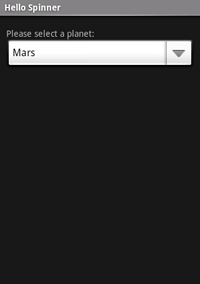Spinner is a widget similar to a drop-down list for selecting items.
In this tutorial, you'll create a simple spinner widget that displays a list of planets. When one is selected, a toast message will display the selected item.
res/layout/main.xml file and insert the following:
<?xml version="1.0" encoding="utf-8"?>
<LinearLayout xmlns:android="http://schemas.android.com/apk/res/android"
android:orientation="vertical"
android:padding="10dip"
android:layout_width="fill_parent"
android:layout_height="wrap_content">
<TextView
android:layout_width="fill_parent"
android:layout_height="wrap_content"
android:layout_marginTop="10dip"
android:text="@string/planet_prompt"
/>
<Spinner
android:id="@+id/spinner"
android:layout_width="fill_parent"
android:layout_height="wrap_content"
android:prompt="@string/planet_prompt"
/>
</LinearLayout>
Notice that the TextView's android:text attribute and the
Spinner's android:prompt attribute both reference the same
string resource. This text behaves as a title for the widget. When applied to the Spinner, the title text will appear
in the selection dialog that appears upon selecting the widget.
strings.xml file in res/values/ and edit the file to look
like this:
<?xml version="1.0" encoding="utf-8"?>
<resources>
<string name="planet_prompt">Choose a planet</string>
<string-array name="planets_array">
<item>Mercury</item>
<item>Venus</item>
<item>Earth</item>
<item>Mars</item>
<item>Jupiter</item>
<item>Saturn</item>
<item>Uranus</item>
<item>Neptune</item>
</string-array>
</resources>
The <string> element defines the title string referenced by the TextView and Spinner in the layout above. The <string-array element defines the list of strings that will be displayed as the list in
the Spinner widget.
HelloSpinner.java file and insert the following code for the onCreate() method:
@Override
public void onCreate(Bundle savedInstanceState) {
super.onCreate(savedInstanceState);
setContentView(R.layout.main);
Spinner spinner = (Spinner) findViewById(R.id.spinner);
ArrayAdapter<CharSequence> adapter = ArrayAdapter.createFromResource(
this, R.array.planets_array, android.R.layout.simple_spinner_item);
adapter.setDropDownViewResource(android.R.layout.simple_spinner_dropdown_item);
spinner.setAdapter(adapter);
}
After the main.xml layout is set as the content view, the Spinner widget is captured from the layout with findViewById(int). The createFromResource() method then
creates a new ArrayAdapter, which binds each item in the string array
to the initial appearance for the Spinner (which is how each item will
appear in the spinner when selected). The R.array.planets_array ID references the string-array defined above and the
android.R.layout.simple_spinner_item ID references a layout for the standard spinner
appearance, defined by the platform. Then setDropDownViewResource(int) is called to define the appearance for
each item when the widget is opened (simple_spinner_dropdown_item is
another standard layout defined by the platform). Finally, the ArrayAdapter
is set to associate all of its items with the Spinner by calling setAdapter(T).
AdapterView.OnItemSelectedListener. This will provide a callback method that will
notify your application when an item has been selected from the Spinner. Here's what this class should look like:
public class MyOnItemSelectedListener implements OnItemSelectedListener {
public void onItemSelected(AdapterView<?> parent,
View view, int pos, long id) {
Toast.makeText(parent.getContext()), "The planet is " +
parent.getItemAtPosition(pos).toString(), Toast.LENGTH_LONG).show();
}
public void onNothingSelected(AdapterView parent) {
// Do nothing.
}
}
The AdapterView.OnItemSelectedListener requires the onItemSelected() and onNothingSelected() callback methods. The former is called when an item from the AdapterView is selected, in which case, a short Toast
message displays the selected text; and the latter is called when a selection disappears from the
AdapterView, which doesn't happen in this case, so it's ignored.
MyOnItemSelectedListener needs to be applied to the Spinner. Go back to the onCreate()
method and add the following line to the end:
spinner.setOnItemSelectedListener(new MyOnItemSelectedListener());
This creates a new anonymous instance of the MyOnItemSelectedListener and sets it as the
listener for the Spinner.
It should look like this:
